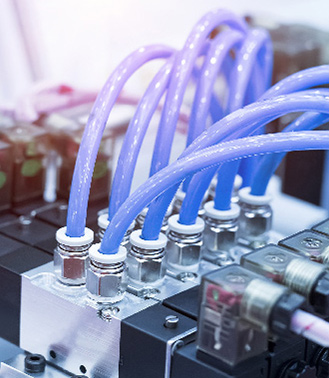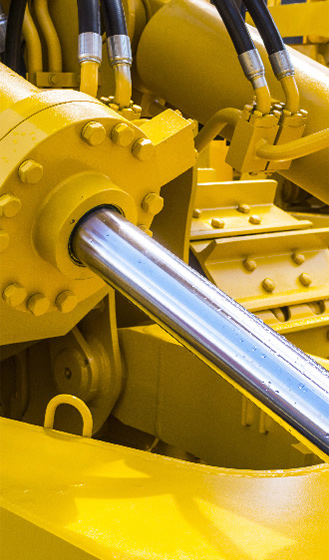Hydraulics Vs Pneumatics
Post By: Ryan King On: 09-02-2021 Read Time: 4 minutes - Guides - Pneumatics
Post By: Ryan King On: 09-02-2021 Read Time: 4 minutes - Guides - Pneumatics
Power for industrial applications usually comes in electrical, mechanical, hydraulic or pneumatic form. While advances in technology have made electro-mechanical actuators much faster, cleaner and more precise, they're still considered weaker and are usually more expensive.
Hydraulic actuators are commonly used for heavier-duty work applications. They can be used for any job where a lot of force is required, such as lifting, pressing and clamping. You'll find them, for example, in construction machinery like cranes, and in mining and cargo handling equipment.
Pneumatic systems don’t produce as much brute power as hydraulics, but they're generally cleaner and faster. Ambient air is still, fortunately, free for your compressor, although other compressed gases are also used.
Both of these are forms of fluid power, with the former using pressurised water or oils, and the latter, pressurised air or gas. Small-scale applications like robotics and food or pharmaceutical laboratories won't work with hydraulics, because these systems generally take up too much space. Conversely, pneumatics are no good for heavy lifting equipment as they don't have enough power.

Air is less resistant than oil or water. Its mass density is much lower, so it can flow much faster through pipework. This high flow rate enables energy to be released rapidly, providing high-speed motion to actuators and other moving parts. Pneumatic actuators achieve higher cycle speeds and duty cycling ratio, which results in increased productivity. These drives can be produced in very small sizes, so are popular in applications requiring miniaturisation, such as robotics.
Pneumatic systems also have a faster response time when changing the state or direction of valves and cylinders, simply by dumping their compressed air.
Hydraulic oil and water both have greater density and resistance, and oil is much slower because it's viscous. It will develop greater force and pressure, but it generally takes a lot longer to activate the system. It also takes a lot longer to vent the system in the event of a leak, as the fluids have to be sent back to their reservoir.
Pneumatic systems are not usually capable of the great strength provided by hydraulics. This means that they're not generally suitable for dealing with heavy loads. While it is possible to compress air or gas up to several hundred pounds per square inch (psi), most industrial applications operate at around 80-100 psi, which is insufficient to develop great force. Fluctuations or sudden drops in pressure can also occur with compressed air, which can lead to jerky or unstable functioning.
The high mass density of hydraulic liquids makes them largely incompressible, so they can develop much more consistent pressure and force. Hydraulic power applications can produce operational pressure from 1,000-5,000 psi. This can go up to 10,000 psi or more for specialised uses, such as heavy lifting cranes and mining equipment.
Pneumatic systems are undoubtedly safer for the industrial environment. Compressed air won't explode and won’t normally catch fire, although it can cause physical injury if pressurised air escapes through some mechanical failure. Compressed air leaks pose no threat of contamination or corrosion, though the same doesn't necessarily apply to other gases. Compressed air is also safer for use in clean environments like laboratories or food hygiene areas.
Hydraulic fluids are always potentially more dangerous. If it's oil it may well be combustible, and extra fire safety precautions will be required. Used oil or other fluids also have to be drained off and eventually disposed of safely. Even water is dangerous, as hot water leaks can cause scalding, while other hydraulic fluids such as oil, plasma, ethylene glycol and fluid synthetics may be poisonous and/or corrosive.
Pneumatic systems tend to be simpler, and operate at lower pressures than hydraulics, so cheaper and simpler materials can be used for their construction. No precautions have to be incorporated against fire or corrosion, and newer, more technologically advanced materials are reducing both weight and bulk.
Hydraulic systems are traditionally more basic, with fewer moving parts, and lever or push-button controls. However, complex engineering is required for their functioning, comprising a storage tank for the oil/water, directional valves and hoses, and an externally powered pump.

Both hydraulic and pneumatic systems usually need electricity to drive them. A pneumatic system also requires an electrically driven compressor to provide a constant supply of compressed air, which can consume a lot of energy. Energy is also lost in the heat produced in compression, and if the system develops a leak this will also cause considerable energy wastage. On the bright side, air is still free, so no energy is demanded to obtain it, replenish it or get rid of waste.
The advantage of a hydraulic system is that you can keep cycling the same fluids. With proper maintenance and a good filtration system, hydraulics can be very energy-efficient over time. On the downside, the pump still needs electricity to drive it and most of this energy is wasted. Even though power is only required for a short time on start-up, the fluid medium has to keep circulating constantly to maintain the system pressure. Also, power consumption rises with viscous fluids, which require more energy to move.
Pneumatics are the cleaner system and easier to maintain, with regular inspection for leaks and maintenance of seals. Air does contain contaminants, however, and important preventative maintenance also includes regular cleaning and replacement of your filter-regulator-lubricator.
The enemy of hydraulic systems is corrosion, unless non-corrosive material is installed for the pipes. Critical components such as hoses, seals and valves need frequent inspection and replacement.
Hydraulics are better for high-force applications requiring strength and positional rigidity, despite any fluctuations in speed. Pneumatics offer flexible airflow, speed and greater precision for specialised applications, particularly in clean or green environments. Ultimately, while performance and energy efficiency on both sides are constantly improving, the question of hydraulics v. pneumatics always depends on the context.